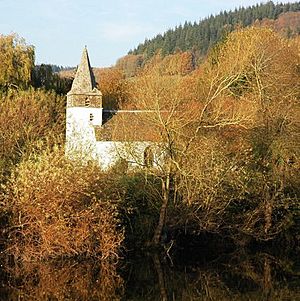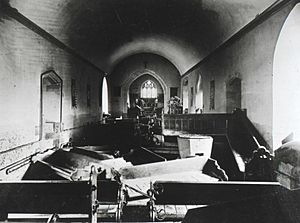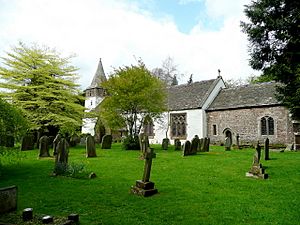St Peter's Church, Dixton facts for kids
Quick facts for kids St Peter's Church, Dixton |
|
|---|---|

The church beside the River Wye
|
|
| 51°49′7.20″N 2°41′59.32″W / 51.8186667°N 2.6998111°W | |
| Location | Dixton, Monmouthshire |
| Country | Wales |
| Denomination | Church of England |
| Website | http://www.achurchnearyou.com/dixton-newton-st-peter/ |
| Administration | |
| Diocese | Hereford |
St Peter's Church is a historic Church of England church in Dixton, Wales. It stands on the green banks of the River Wye, about one mile (1.6 km) northeast of the town of Monmouth. Because of its long history and special architecture, the church is a Grade II* listed building. This means it is a very important building that must be protected. The ancient cross in its churchyard is also a protected monument.
Contents
History of the Church
The story of St Peter's Church goes back a very long time. It is so old that it was already called an "old church" in the year 735!
An Ancient Beginning
The first record of a church at this spot comes from the Book of Llandaff, an old Welsh manuscript. It mentions a church or monastery here around the year 735. At that time, it was dedicated to a Welsh saint named Tydiwg. The Welsh name for the area, Llandydiwg, comes from this saint, and over time, this became the name Dixton.
Building Through the Ages
The church you see today has a simple design with a main hall (the nave), a special area for the altar (the chancel), a tower, and two porches. Some parts of the church are incredibly old. The north wall of the nave has a special pattern of stones called herring-bone masonry (or opus spicatum). This style might have been built by the Anglo-Saxons over 1,000 years ago, or it could be from the 12th century.
The church was made larger in the 13th century when the tower and chancel were likely added. In 1397, someone wrote that the church was "intolerably dark" inside. Today, it is much brighter thanks to several windows. The walls of the chancel are made of Old Red Sandstone from the 14th century. Inside the church, you can also see a painted royal coat of arms from 1711.
The church was repaired and restored between 1861 and 1862. It has five beautiful stained glass windows. One window, made in 1862, shows a story from the Bible. Another from 1871 shows the Sermon on the Mount. The newest large window was added in 1954.
Surviving the Floods
Because St Peter's is so close to the River Wye, it sometimes floods in the winter. The water can get inside the building. To show how high the water has reached, there are small brass plates on the wall near the chancel.
To protect important items from floodwater, a special wooden balcony was built at the back of the church. This allows precious things to be stored high and dry.
A Welsh Church in England's Diocese
One of the most unusual things about St Peter's is that it is part of the Church of England, even though it is in Wales. This is because of a special decision made over 100 years ago.
For a long time, the church was part of an English diocese. In 1844, it was moved to a Welsh one. But in the early 1900s, the Church in Wales was preparing to become independent from the Church of England. In 1915, the people who attended St Peter's Church voted to stay with the Church of England. So, in 1920, the church was officially returned to the English Diocese of Hereford, where it remains today.



